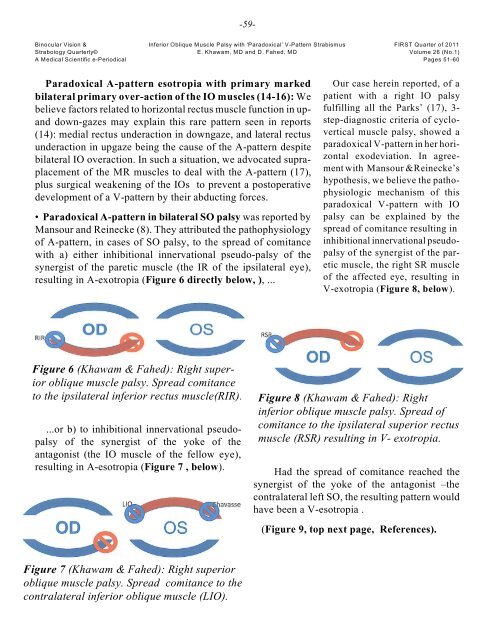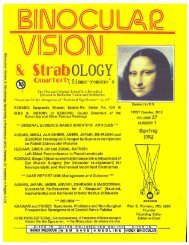Correspondence - ICO Library
Correspondence - ICO Library
Correspondence - ICO Library
Create successful ePaper yourself
Turn your PDF publications into a flip-book with our unique Google optimized e-Paper software.
-59-<br />
Binocular Vision & Inferior Oblique Muscle Palsy with ‘Paradoxical’ V-Pattern Strabismus FIRST Quarter of 2011<br />
Strabology Quarterly© E. Khawam, MD and D. Fahed, MD Volume 26 (No.1)<br />
A Medical Scientific e-Periodical Pages 51-60<br />
Paradoxical A-pattern esotropia with primary marked<br />
bilateral primary over-action of the IO muscles (14-16): We<br />
believe factors related to horizontal rectus muscle function in upand<br />
down-gazes may explain this rare pattern seen in reports<br />
(14): medial rectus underaction in downgaze, and lateral rectus<br />
underaction in upgaze being the cause of the A-pattern despite<br />
bilateral IO overaction. In such a situation, we advocated supraplacement<br />
of the MR muscles to deal with the A-pattern (17),<br />
plus surgical weakening of the IOs to prevent a postoperative<br />
development of a V-pattern by their abducting forces.<br />
• Paradoxical A-pattern in bilateral SO palsy was reported by<br />
Mansour and Reinecke (8). They attributed the pathophysiology<br />
of A-pattern, in cases of SO palsy, to the spread of comitance<br />
with a) either inhibitional innervational pseudo-palsy of the<br />
synergist of the paretic muscle (the IR of the ipsilateral eye),<br />
resulting in A-exotropia (Figure 6 directly below, ), ...<br />
Our case herein reported, of a<br />
patient with a right IO palsy<br />
fulfilling all the Parks’ (17), 3-<br />
step-diagnostic criteria of cyclovertical<br />
muscle palsy, showed a<br />
paradoxical V-pattern in her horizontal<br />
exodeviation. In agreement<br />
with Mansour &Reinecke’s<br />
hypothesis, we believe the pathophysiologic<br />
mechanism of this<br />
paradoxical V-pattern with IO<br />
palsy can be explained by the<br />
spread of comitance resulting in<br />
inhibitional innervational pseudopalsy<br />
of the synergist of the paretic<br />
muscle, the right SR muscle<br />
of the affected eye, resulting in<br />
V-exotropia (Figure 8, below).<br />
Figure 6 (Khawam & Fahed): Right superior<br />
oblique muscle palsy. Spread comitance<br />
to the ipsilateral inferior rectus muscle(RIR).<br />
...or b) to inhibitional innervational pseudopalsy<br />
of the synergist of the yoke of the<br />
antagonist (the IO muscle of the fellow eye),<br />
resulting in A-esotropia (Figure 7 , below).<br />
Figure 8 (Khawam & Fahed): Right<br />
inferior oblique muscle palsy. Spread of<br />
comitance to the ipsilateral superior rectus<br />
muscle (RSR) resulting in V- exotropia.<br />
Had the spread of comitance reached the<br />
synergist of the yoke of the antagonist –the<br />
contralateral left SO, the resulting pattern would<br />
have been a V-esotropia .<br />
(Figure 9, top next page, References).<br />
Figure 7 (Khawam & Fahed): Right superior<br />
oblique muscle palsy. Spread comitance to the<br />
contralateral inferior oblique muscle (LIO).









